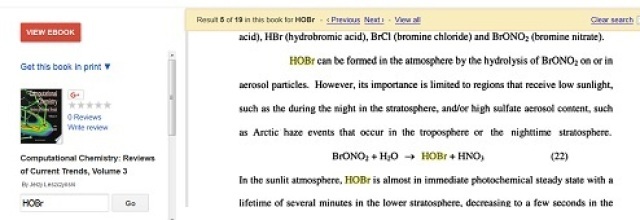hypobromous acid intermolecular force?
2018-02-14 11:21 am
回答 (2)
2018-02-14 11:36 am
Pure hypobromous acid (HBrO) does not exist. Hypobromous acid only exists in aqueous solutions.
In aqueous hypobromous acid, small amount (less than 5%) of hypobromous acid ionizes to give hydrogen ions and hypobromite ions. The intermolecular forces between hypobromous acid molecules and water molecules are hydrogen bonds.
In aqueous hypobromous acid, small amount (less than 5%) of hypobromous acid ionizes to give hydrogen ions and hypobromite ions. The intermolecular forces between hypobromous acid molecules and water molecules are hydrogen bonds.
2018-02-14 11:43 am
Hypobromous acid.....
The formula is HOBr. It exists as an unstable molecule in the gas phase*, and is a weak acid which isn't stable in aqueous solution. It can form briefly in the atmosphere and then react to form HBr(g) and HBrO3(g).
..... 3HOBr(g) --> 2HBr(g) + HBrO3(g)
A similar reaction occurs in aqueous solution, producing the strong acid HBr and the marginally weak acid HBrO3.
In the gas phase HOBr does not exhibit hydrogen bonding between like molecules. The molecules are bent and therefore, polar. Therefore, all three van der Waals forces exist between the molecules. There are three van der Waals forces: Keesom forces (dipole-dipole attraction), Debye forces (induced attraction) and London dispersion forces (all molecules exhibit them). The strength of London dispersion forces is directly proportional to the polarizability of the molecule, which it turn, depends on the total number of electrons and the area over which they are spread. It is only coincidental that the boiling points of molecules increase with molecular weight.
* https://books.google.com/books?id=1omQQdWfYwMC&pg=PA88&lpg=PA88&dq=HOBr&source=bl&ots=x2SaOMLnjE&sig=BgqMtmIHkJ2n07Em2WUkUtIOjHM&hl=en&sa=X&ved=0ahUKEwiSov64u6TZAhVM74MKHaxDD8g4ChDoAQhcMAg#v=onepage&q=HOBr&f=false
The formula is HOBr. It exists as an unstable molecule in the gas phase*, and is a weak acid which isn't stable in aqueous solution. It can form briefly in the atmosphere and then react to form HBr(g) and HBrO3(g).
..... 3HOBr(g) --> 2HBr(g) + HBrO3(g)
A similar reaction occurs in aqueous solution, producing the strong acid HBr and the marginally weak acid HBrO3.
In the gas phase HOBr does not exhibit hydrogen bonding between like molecules. The molecules are bent and therefore, polar. Therefore, all three van der Waals forces exist between the molecules. There are three van der Waals forces: Keesom forces (dipole-dipole attraction), Debye forces (induced attraction) and London dispersion forces (all molecules exhibit them). The strength of London dispersion forces is directly proportional to the polarizability of the molecule, which it turn, depends on the total number of electrons and the area over which they are spread. It is only coincidental that the boiling points of molecules increase with molecular weight.
* https://books.google.com/books?id=1omQQdWfYwMC&pg=PA88&lpg=PA88&dq=HOBr&source=bl&ots=x2SaOMLnjE&sig=BgqMtmIHkJ2n07Em2WUkUtIOjHM&hl=en&sa=X&ved=0ahUKEwiSov64u6TZAhVM74MKHaxDD8g4ChDoAQhcMAg#v=onepage&q=HOBr&f=false

收錄日期: 2021-04-24 00:57:26
原文連結 [永久失效]:
https://hk.answers.yahoo.com/question/index?qid=20180214032125AAunn1A
